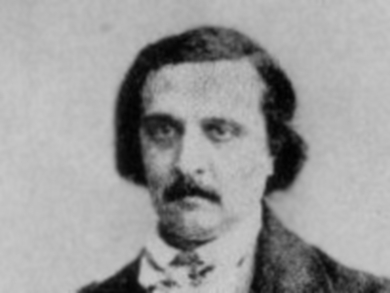Charles Frédéric Gerhardt was born on August 21, 1816, in Strasbourg, France. His father owned a factory that produced white lead (2 PbCO3·Pb(OH)2), used as a white pigment at the time. Gerhardt jr. was encouraged to study science with the hope of taking over the factory one day. He was sent to Karlsruhe Polytechnic (today: Karlsruhe Institute of Technology, KIT) in Germany to study chemistry in 1831 and moved to Leipzig, Germany, in 1833 to continue his studies under Otto Linné Erdmann.
Gerhardt attempted to work in the family’s white lead factory, which ended in a heated argument. Unable to reconcile with his father, he left Strasbourg and joined the military. After a short time, he managed to buy his way of out military service and joined Justus von Liebig, the “father of the fertilizer industry” and eminent organic chemist, in Gießen, Germany, to continue his studies. He returned to France and received his doctorate from the University of Paris in 1841 under the supervision of Jean-Baptiste Dumas.
Charles Gerhardt started to work as Temporary Professor of Chemistry at the University of Montpellier, France, in 1844. He closely collaborated with Auguste Laurent at the University of Bordeaux, France. When Laurent moved to Paris, Gerhardt followed him, resigned his post in Montpellier, and founded a private school for chemistry to support himself.
Gerhardt’s work brought some much-needed order to organic chemistry: He came up with the concept of homologous series (related compounds that differ only in the number of CH2 units) in 1843. The concept allowed chemists to predict reactions of compounds using known reactions of similar compounds. He also introduced a “Theory of Types”, claiming that classes of similar organic compounds could be derived from, e.g., water or ammonia by adding different residues. In this way, alcohols and ethers belonged to a “water type”, amines to the “ammonia type”, etc. This classification system was a foundation for organic structure theory, later developed by August Kekulé.
Charles Gerhardt also dealt with the inconsistency in the way chemical formulas were written at the time. Due to differing opinions about atomic weights, the number of atoms in the formulas were double or four times has high as today. Water, for example, was often denoted as H4O2, benzene could be written as C12H5H or C24H10H2. Gerhardt proposed reducing these formulas to today’s notation. This change implied that many organic formulas with odd numbers of atoms were based on wrong analytical data, which irritated and alienated his colleagues who had performed the work in question. Together with Laurent, Gerhardt reanalyzed many of the compounds in question.
Later, Gerhardt worked on the synthesis of acid anhydrides. His success in this area ended his ostracism from the “mainstream” chemical community. He was appointed Professor of Chemistry at the University of Strasbourg in 1855. Charles Frédéric Gerhardt died in Strasbourg on August 19, 1856, shortly before his 40th birthday.
Charles Frédéric Gerhardt is the answer to Guess the Chemist (56).
Sources
- Charles Gerhardt,
Nicholas W. Fisher,
www.britannica.com (accessed July 13, 2016). - Charles Gerhardt and the theory of organic combination,
Jimmy Dickerson,
J. Chem. Educ. 1985, 62, 323–325.
DOI: 10.1021/ed062p323
Selected Publications
- Ueber die Einwirkung des Phosphorsuperchlorids auf einige Amide (in German),
C. Gerhardt,
Ann. Chem. Pharm. 1858, 108, 214–223.
DOI: 10.1002/jlac.18581080210 - Recherches sur les acides organiques anhydres (in French),
C. Gerhardt,
Ann. Chim. Phys. 1853, 37, 285–342. - Ueber salpetersaure und salpetrigsaure Salze (in German),
C. Gerhardt,
J. Prakt. Chem. 1846, 39, 136–143.
DOI: 10.1002/prac.18460390126 - Untersuchungen über die organischen Basen (in German),
C. Gerhardt,
Ann. Chem. Pharm. 1842, 42, 310–313.
DOI: 10.1002/jlac.18420420310 - Recherches chimiques sur les huiles essentielles. Premier Mémoire (in French),
C. Gerhardt, A. Cahours,
Ann. Chim. Phys. 1841, 1, 60–62.




